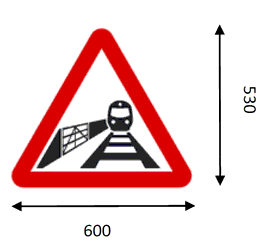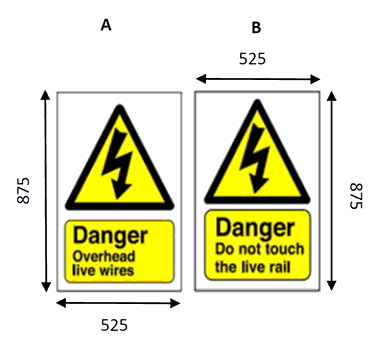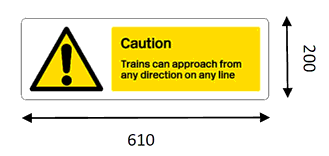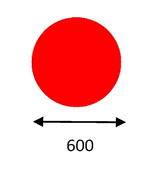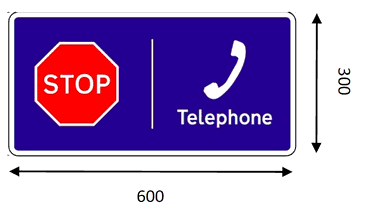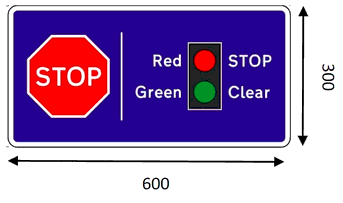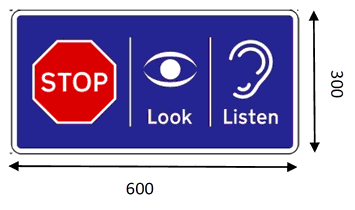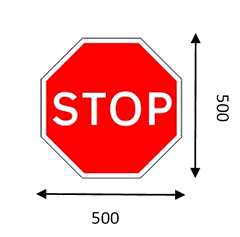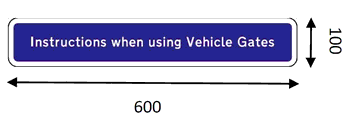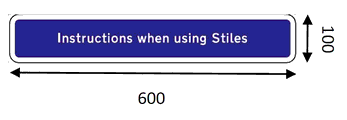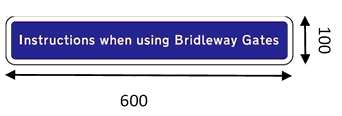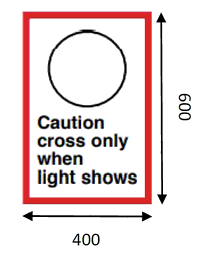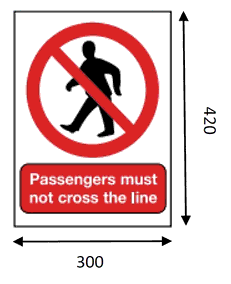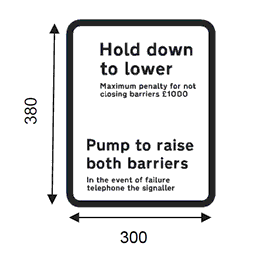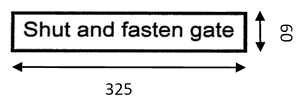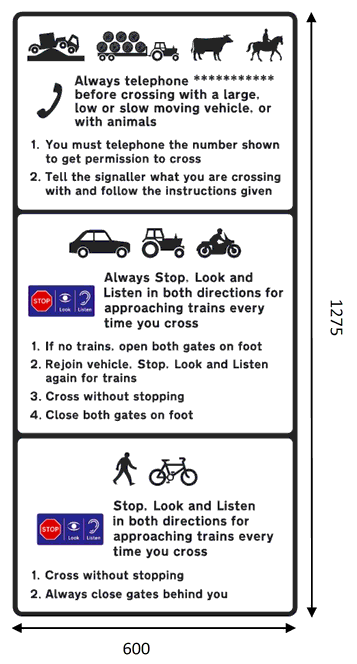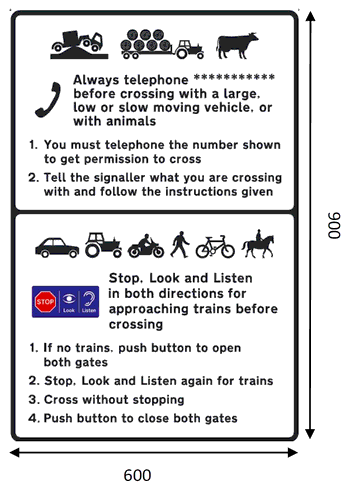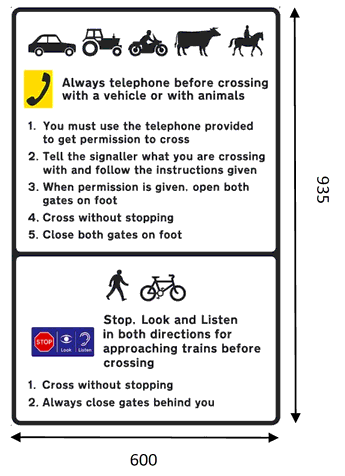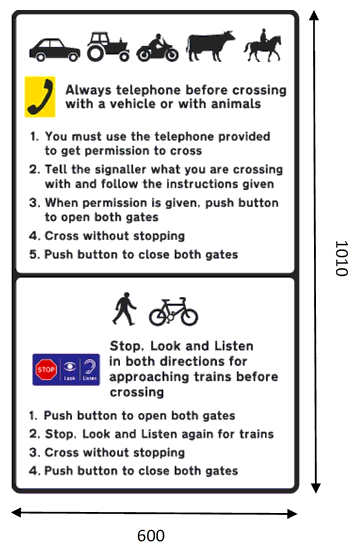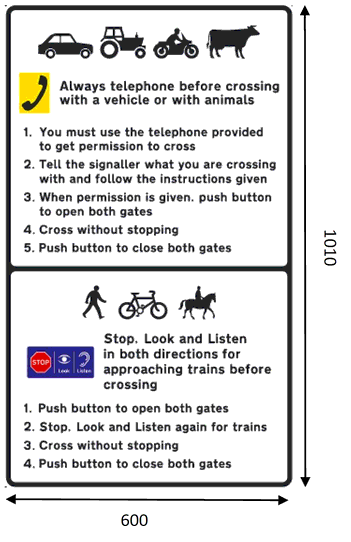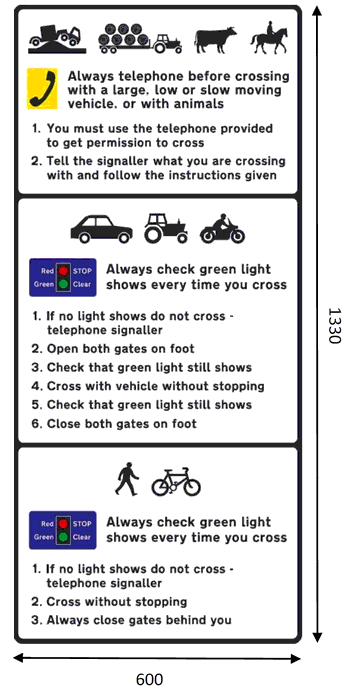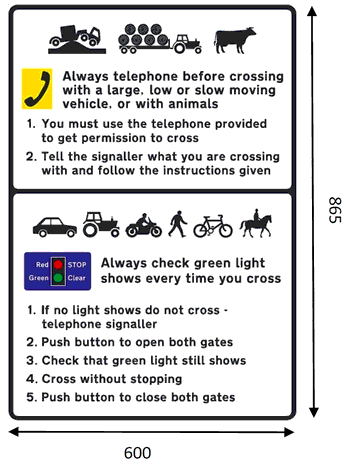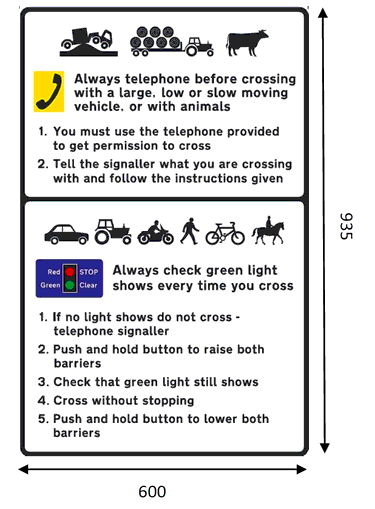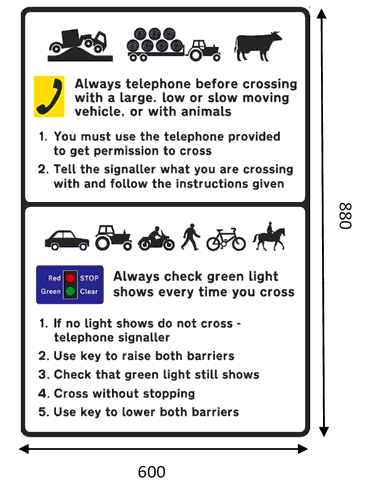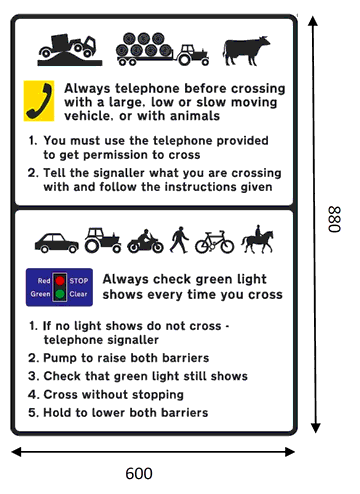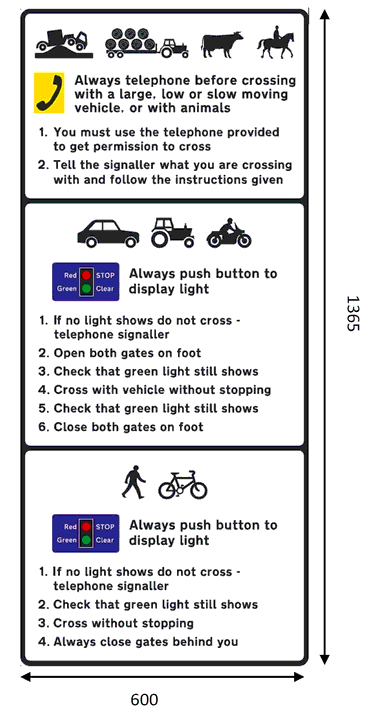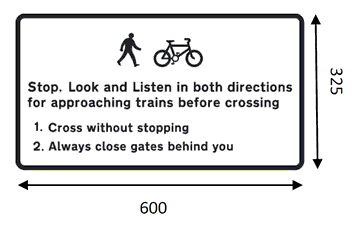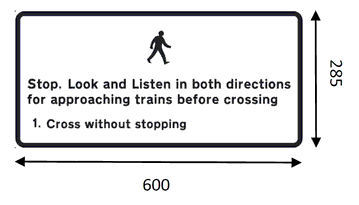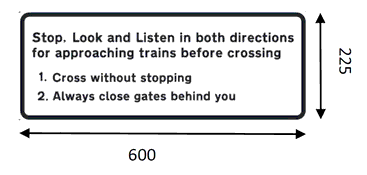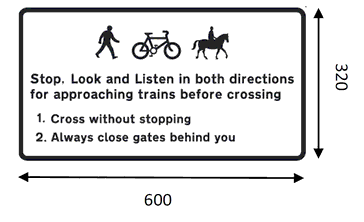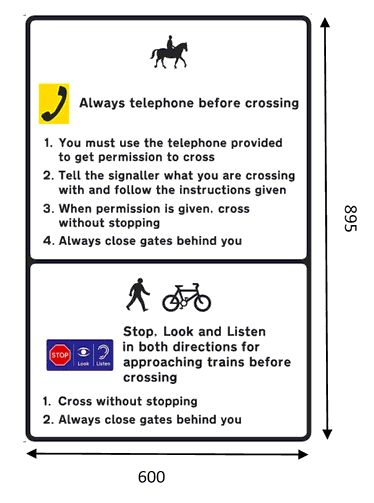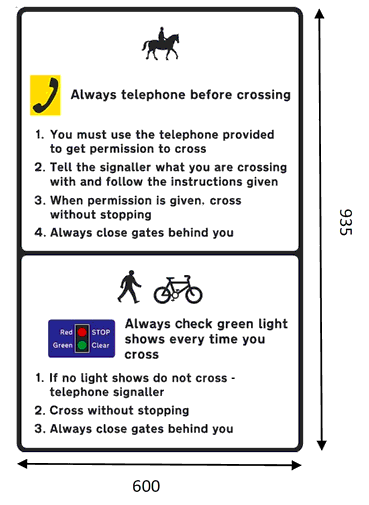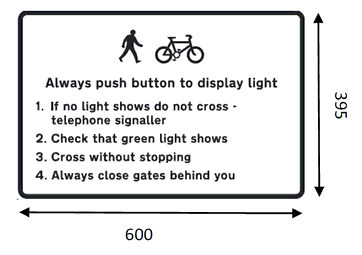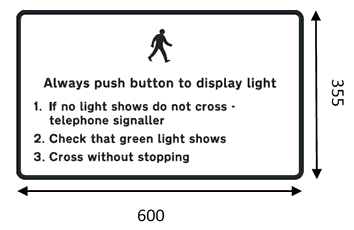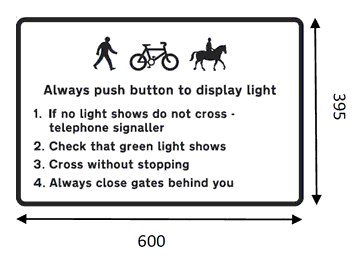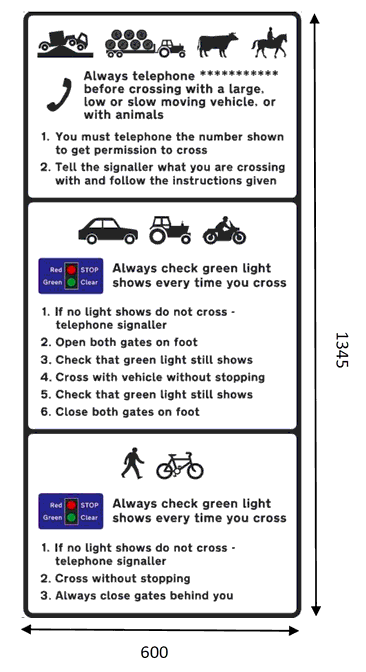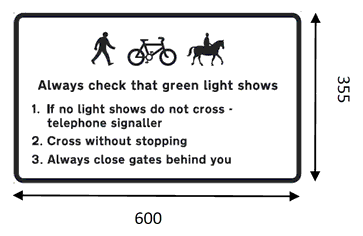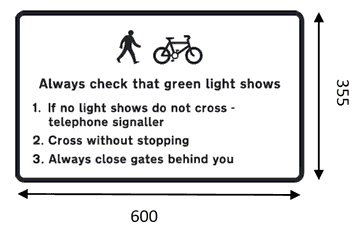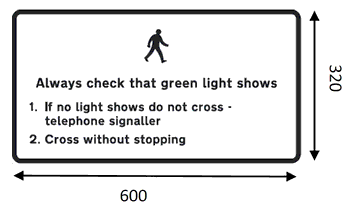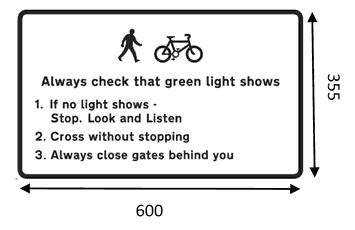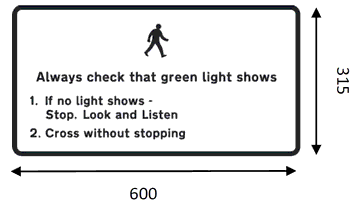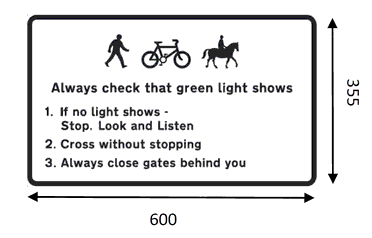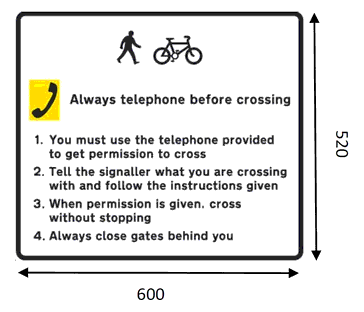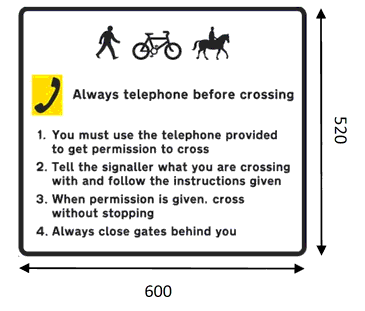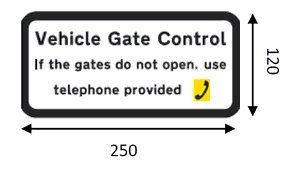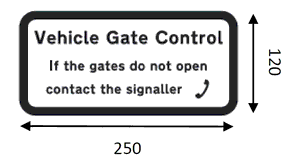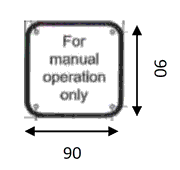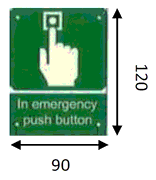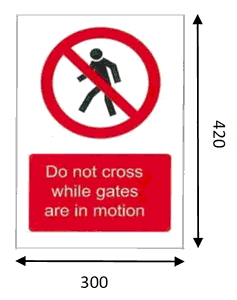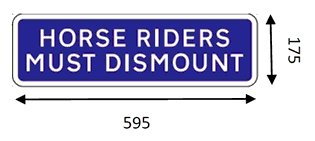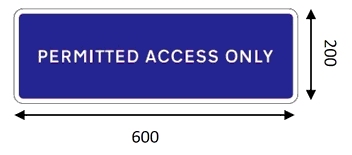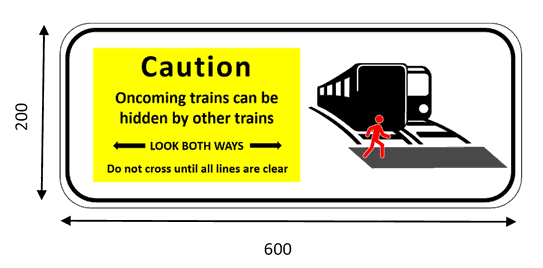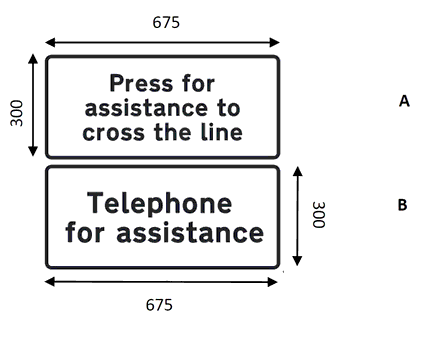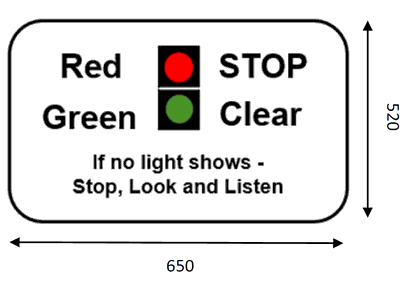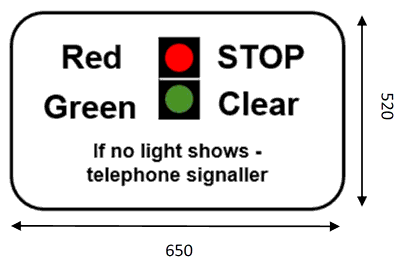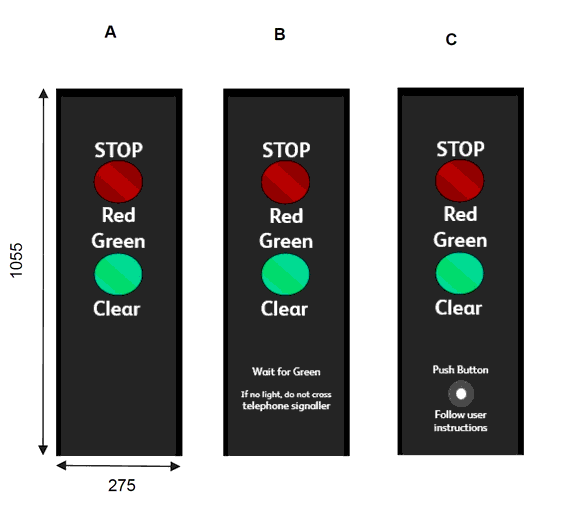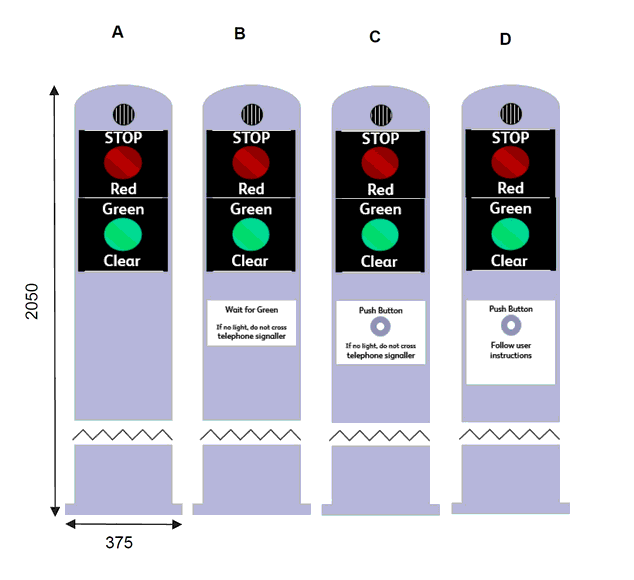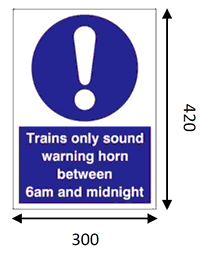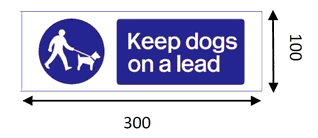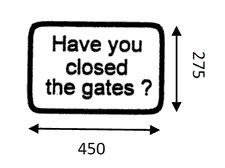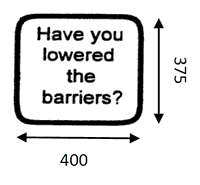Statutory Instruments
2023 No. 1112
RAILWAYS
The Private Crossings (Signs and Barriers) Regulations 2023
Made
23rd October 2023
Laid before Parliament
26th October 2023
Coming into force
18th November 2023
The Secretary of State makes these Regulations in exercise of the powers conferred by section 52(1)(a), (3) and (5) of the Transport and Works Act 1992(1).
Citation, commencement and extentE+W+S
1.—(1) These Regulations may be cited as the Private Crossings (Signs and Barriers) Regulations 2023.
(2) These Regulations come into force on 18th November 2023.
(3) These Regulations extend to England and Wales and Scotland.
Commencement Information
I1Reg. 1 in force at 18.11.2023, see reg. 1(2)
InterpretationE+W+S
2. In these Regulations—
“the 2016 Regulations” means the Traffic Signs Regulations and General Directions 2016(2);
“crossing” means a place where a railway or tramway is crossed by a relevant road;
“crossing operator” means the operator of a railway or tramway that is crossed in any place by a relevant road;
“relevant road” means—
a private road;
a private path; or
both a private road and a private path;
“retroreflecting material” means material which reflects a ray of light back towards the source of that light;
“signaller” means a person employed by a crossing operator who operates signals, and where applicable the points, on a railway or tramway or otherwise controls the movement of trains or trams.
Commencement Information
I2Reg. 2 in force at 18.11.2023, see reg. 1(2)
Crossing signs to be of the size, colour and type describedE+W+S
3.—(1) Subject to regulations 5, 6 and 9, where a crossing operator causes or permits a crossing sign to be placed on or near a relevant road at or near a crossing, the crossing sign must be of the size, colour and type shown and described in—
(a)a diagram in Schedule 1; or
(b)any of the following diagrams set out in the signs tables in the following Schedules to the 2016 Regulations—
(i)Schedule 2—
(aa)Part 2: diagrams 770 (Item 51), 771 (Item 52), 772 (Item 53), 779 (Item 54) and 782 (Item 55),
(bb)Part 6: diagrams 774 (Item 4) and 781 (Item 5);
(ii)Schedule 9—
(aa)Part 2: diagrams 602 (Item 2), 778 (Item 4) and 778.1 (Item 5),
(bb)Part 4: diagram 784.1 (Item 4),
(cc)Part 6: diagrams 1002.1 (Item 1), 1022 (Item 2), 1003A (Item 3), 1023A (Item 4), 1013.1 (Item 23) and 1045 (Item 26);
(iii)Schedule 11—
(aa)Part 2: diagrams 963.3 (Item 43), 775 (Item 67), 783 (Item 68), 785.1 (Item 69), 786 (Item 70), 787 (Item 71) and 788 (Item 72),
(bb)Part 4: diagrams 1004 (Item 2), 1012.1 (Item 11) and 1026 (Item 16);
(iv)Schedule 14—
(aa)Part 2: diagrams 3014 (Item 5), 773 (Item 6), 776 and 777 (Item 8), 1001 (Item 46), 790 (Item 67) and 1003.2 (Item 68).
(2) Where, in accordance with these Regulations, a crossing operator causes or permits the placement of a crossing sign referred to in paragraph (1)(b), the provisions of the 2016 Regulations relating to the size, illumination and significance of, and the requirements conveyed by, that sign by virtue of those Regulations apply to that crossing sign as if the relevant road concerned were a road as defined in section 142 of the Road Traffic Regulation Act 1984(3).
Commencement Information
I3Reg. 3 in force at 18.11.2023, see reg. 1(2)
Colours of backs of crossing signsE+W+S
4. The back of a crossing sign shown in a diagram in Schedule 1 and any pole or other structure provided for mounting the crossing sign shall be black or grey in colour.
Commencement Information
I4Reg. 4 in force at 18.11.2023, see reg. 1(2)
DimensionsE+W+S
5.—(1) A variation in a dimension specified in Schedule 1 is permitted by these Regulations if the variation does not exceed 5% more or 5% less than the dimension specified.
(2) In Schedule 1 the dimensions of the crossing signs are expressed in millimetres.
Commencement Information
I5Reg. 5 in force at 18.11.2023, see reg. 1(2)
Permitted variantsE+W+S
6.—(1) The crossing signs shown in diagrams 102, 106, 157, 160, 161, 162 and 164 in Schedule 1 may be varied as set out in Schedule 1 where the circumstances so require.
(2) A crossing sign shown in diagrams 104 and 118 in Schedule 1 may be varied to show a different penalty where the maximum penalty for failing to comply with the requirement on the crossing sign has changed.
(3) In relation to a crossing sign shown in diagrams 106 (variant B), 120, 121, 140, and 164 (variants B, C and D) in Schedule 1, the telephone number may be changed if the number of the signaller changes.
Commencement Information
I6Reg. 6 in force at 18.11.2023, see reg. 1(2)
Illumination of crossing signsE+W+S
7.—(1) Subject to paragraph (2), the front of a crossing sign shown in the diagrams in Schedule 1 must be covered in retroreflecting material.
(2) Retroreflecting material must not be applied to—
(a)any part of a crossing sign, including words, coloured black;
(b)the red and green lights prescribed in regulation 8 in a crossing sign shown in a diagram in Part 4 of Schedule 1; and
(c)a crossing sign at a crossing which motor vehicles do not use.
Commencement Information
I7Reg. 7 in force at 18.11.2023, see reg. 1(2)
Miniature stop lightsE+W+S
8.—(1) The crossing signs shown in diagrams 158, 159, 160 and 161 in Part 4 of Schedule 1 must contain red and green lights which—
(a)are internally illuminated by a steady light so that—
(i)when one light is lit, the other is not;
(ii)the green light is and remains lit so long as no railway or tramway vehicle is approaching the vicinity of the crossing from either direction; and
(iii)the red light is and remains lit if the green light is not lit; or
(b)are activated either by the user pushing a button, or by a motion sensor so that—
(i)when one light is lit, the other is not;
(ii)the green light is only activated so long as no railway or tramway vehicle is approaching the vicinity of the crossing from either direction; and
(iii)the red light is and remains activated until the green light is lit.
(2) The lenses of the lights must be—
(a)circular and not less than 60 millimetres in diameter; or
(b)rectangular with the short side measuring a minimum of 60 millimetres;
and the distance between the edges of the lenses of the lights must be not less than 40 millimetres.
(3) The information, warnings, requirements and prohibitions conveyed by the lights described in paragraphs (1) and (2) are—
(a)the red light when lit warns the user of a crossing that a railway or tramway vehicle is approaching the vicinity of that crossing and users are prohibited from using the crossing;
(b)the green light when lit informs the user of a crossing that no railway or tramway vehicle is approaching the vicinity of that crossing and users may use the crossing;
(c)if neither light is lit, users must either telephone the signaller, or cross the railway or tramway with caution after following the instructions on any crossing sign at or near the crossing.
Commencement Information
I8Reg. 8 in force at 18.11.2023, see reg. 1(2)
Crossing signs relating to telephonesE+W+S
9.—(1) The crossing signs shown in a diagram in Schedule 1 which incorporates a telephone symbol highlighted in yellow is permitted to be placed only where there is a fixed telephone, which connects directly to the signaller, provided at each side of the crossing.
(2) The crossing signs shown in diagrams in Schedule 1 which have space designated on them for a telephone number must show the telephone number to contact the signaller. Such crossing signs are only permitted to be placed under these Regulations where there are no fixed telephones at the crossing.
Commencement Information
I9Reg. 9 in force at 18.11.2023, see reg. 1(2)
Gates or barriers to be of the character described in Schedule 2 or Schedule 3E+W+S
10. Where a crossing operator causes or permits the placement of a barrier on a relevant road near a crossing, the barrier must, in the case of a gate, be of the character described in Schedule 2, or in the case of any other barrier be of the character described in Schedule 3.
Commencement Information
I10Reg. 10 in force at 18.11.2023, see reg. 1(2)
RevocationE+W+S
11. The Private Crossings (Signs and Barriers) Regulations 1996(4) are revoked.
Commencement Information
I11Reg. 11 in force at 18.11.2023, see reg. 1(2)
Signed by authority of the Secretary of State for Transport
Huw Merriman
Minister of State
Department for Transport
23rd October 2023
Regulation 3
Schedule 1E+W+SCrossing signs
Part 1E+W+SWarning signs
Commencement Information
I12Sch. 1 Pt. 1 in force at 18.11.2023, see reg. 1(2)
Diagram 106 Permitted variants A or B: On sign B, the telephone number for the signaller must be provided at crossings with no fixed telephones.
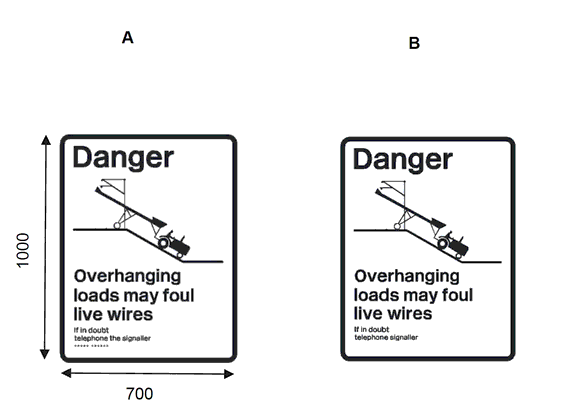
Part 2E+W+SSummary signs and stop sign
Commencement Information
I13Sch. 1 Pt. 2 in force at 18.11.2023, see reg. 1(2)
Part 3E+W+SInstruction signs
Commencement Information
I14Sch. 1 Pt. 3 in force at 18.11.2023, see reg. 1(2)
Part 4E+W+SMiniature stop light instructions and units
Commencement Information
I15Sch. 1 Pt. 4 in force at 18.11.2023, see reg. 1(2)
Part 5E+W+SInformation signs
Commencement Information
I16Sch. 1 Pt. 5 in force at 18.11.2023, see reg. 1(2)
Diagram 164: Permitted variant: the appropriate variant (A, B, C, or D) may be placed according to the circumstances at the crossing.
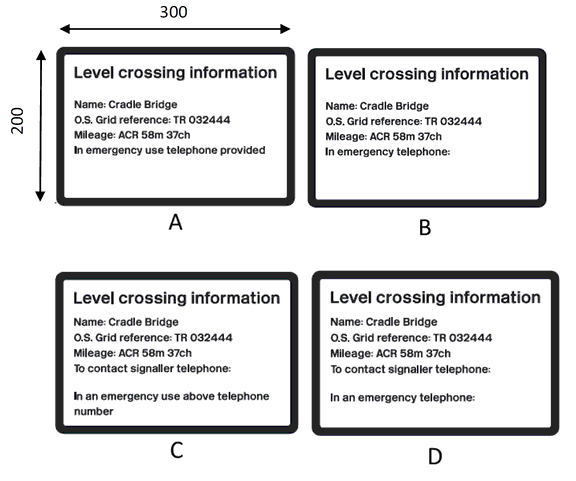
Part 6E+W+SReminder signs
Commencement Information
I17Sch. 1 Pt. 6 in force at 18.11.2023, see reg. 1(2)
Regulation 10
Schedule 2E+W+SGates
1. A gate must, by itself or with another gate on the same side of the railway or tramway, be long enough to extend across the full width of the relevant road.E+W+S
Commencement Information
I18Sch. 2 para. 1 in force at 18.11.2023, see reg. 1(2)
2. Where gates are placed, they must pivot to open away from the railway or tramway.E+W+S
Commencement Information
I19Sch. 2 para. 2 in force at 18.11.2023, see reg. 1(2)
3. When a gate is closed, the top surface of the gate must be a minimum of 1350 millimetres above the road surface at the centre of the relevant road.E+W+S
Commencement Information
I20Sch. 2 para. 3 in force at 18.11.2023, see reg. 1(2)
4. The underclearance between each gate and the road must not exceed 150 millimetres. If the relevant road is an unmetalled track, the underclearance between the gate and the road may be greater than 150 millimetres only if necessary to avoid the gate grounding during opening and closing.E+W+S
Commencement Information
I21Sch. 2 para. 4 in force at 18.11.2023, see reg. 1(2)
5. Where a gate is installed otherwise than for the sole use of pedestrians, it must have a way to secure it in the open and in the closed positions.E+W+S
Commencement Information
I22Sch. 2 para. 5 in force at 18.11.2023, see reg. 1(2)
6. A gate must be as light in weight as possible but nevertheless strong enough to withstand distortion or breakage caused by wind pressure or by a farm animal.E+W+S
Commencement Information
I23Sch. 2 para. 6 in force at 18.11.2023, see reg. 1(2)
Regulation 10
Schedule 3E+W+SBarriers other than gates
1.—(1) Where a barrier, other than a gate, is placed, it must when lowered across the relevant road be long enough to extend either—E+W+S
(a)across the full width of the relevant road, or
(b)subject to paragraph (2), from the left-hand side of the relevant road (as seen from a vehicle approaching the crossing) to a point as close as possible to the centre of the relevant road.
(2) In a case falling within paragraph (1)(b), there must be a minimum distance of 3 metres from the tip or, as the case may be, vertical edge of the barrier to the other side of the relevant road to allow clear passage.
Commencement Information
I24Sch. 3 para. 1 in force at 18.11.2023, see reg. 1(2)
2. When a barrier is lowered its top surface must be a minimum height of 900 millimetres above the road surface at the centre of the relevant road.E+W+S
Commencement Information
I25Sch. 3 para. 2 in force at 18.11.2023, see reg. 1(2)
3. The underclearance between the barrier when lowered and the road surface must not exceed 1000 millimetres.E+W+S
Commencement Information
I26Sch. 3 para. 3 in force at 18.11.2023, see reg. 1(2)
4. A barrier must have means to raise it, and hold it in the raised position. It must also have means to release the hold and allow the barrier to return to a horizontal position.E+W+S
Commencement Information
I27Sch. 3 para. 4 in force at 18.11.2023, see reg. 1(2)
5. A barrier may be linked with another barrier at the crossing to allow all the barriers to be raised or lowered simultaneously from either side of the crossing.E+W+S
Commencement Information
I28Sch. 3 para. 5 in force at 18.11.2023, see reg. 1(2)
6. The pivot post of a barrier must be covered to avoid injury to persons using it.E+W+S
Commencement Information
I29Sch. 3 para. 6 in force at 18.11.2023, see reg. 1(2)
7. A barrier must have on both front and rear faces alternate red and white bands each approximately 600 millimetres wide (measured horizontally across the face of the barrier) and to the full depth of the barrier measured vertically on the full face of the barrier when horizontal. A strip of retroreflecting material not less than 50 millimetres deep, in a colour matching that of the bands must be attached along the full width of each band.E+W+S
Commencement Information
I30Sch. 3 para. 7 in force at 18.11.2023, see reg. 1(2)
8. A barrier may be fitted with a skirt which fills the space between the barrier and the road surface. Any skirt must be light in colour.E+W+S
Commencement Information
I31Sch. 3 para. 8 in force at 18.11.2023, see reg. 1(2)
9. Electric lights may be fitted to a barrier and each light must show a red light, when illuminated, in each direction along the relevant road.E+W+S
Commencement Information
I32Sch. 3 para. 9 in force at 18.11.2023, see reg. 1(2)
10. A barrier, with or without a skirt if fitted, must be as lightweight as possible but nevertheless—E+W+S
(a)a barrier must be strong enough to withstand distortion or breakage, and
(b)a skirt fitted to a barrier must be capable of withstanding damage
caused by wind pressure or by a farm animal.
Commencement Information
I33Sch. 3 para. 10 in force at 18.11.2023, see reg. 1(2)
Explanatory Note
(This note is not part of the Regulations)
Section 52 of the Transport and Works Act 1992 allows the operator of a railway or tramway that is crossed by a private road or private path to cause or permit the placement near the crossing of crossing signs or barriers that are prescribed in regulations made by the Secretary of State, or as otherwise authorised by the Secretary of State.
These Regulations prescribe crossing signs and barriers which may be placed on or near a private road or private path at or near the crossing as provided for in that section.
A full impact assessment has not been produced for this instrument because no, or no significant, impact on the private, voluntary or public sector is foreseen. An Explanatory Memorandum has been produced for this instrument and is published alongside this instrument at www.legislation.gov.uk.
S.I. 2016/362. These Regulations and General Directions have been amended but those amendments are not relevant to this instrument.
